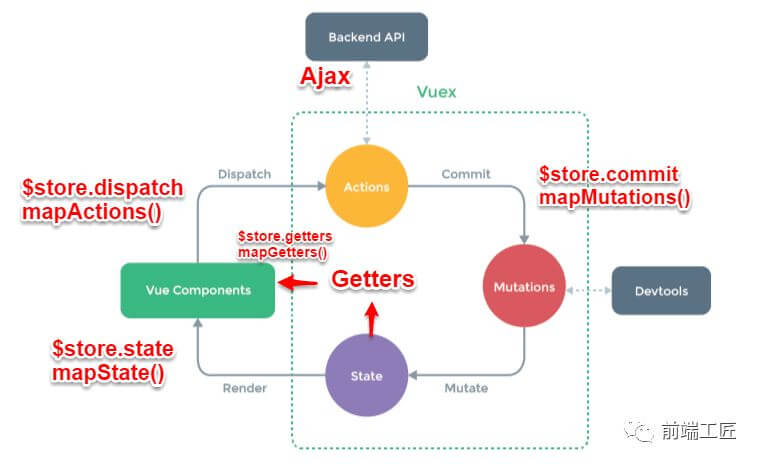Vue 2.x 组件通信方式
2020/3/30大约 5 分钟
Vue 2.x 组件通信方式
props / $emit
- 父组件A -> 子组件B: 通过
props传递参数 - 子组件B -> 父组件A: 子组件B 中
$emit触发事件并携带参数, 在 父组件A 中使用v-on监听
$emit / $on
通过一个空的Vue实例作为中央事件总线(事件中心),用它来触发事件和监听事件,巧妙而轻量地实现了任何组件间的通信,包括父子、兄弟、跨级。
var Event = new Vue();
Event.$emit(事件名, 数据);
// 因为有时不确定何时会触发事件,一般会在 mounted 或 created 钩子中来监听。
Event.$on(事件名, data => {});Vuex

Vuex与localStorage- 问题: vuex 是 vue 的状态管理器, 刷新之后数据不会保存。
- 解决方法: 在vuex里数据改变的时候把数据拷贝一份保存到localStorage里面,刷新之后,如果localStorage里有保存的数据,取出来再替换store里的state。
注:
localStorage只支持字符串,所以需要用JSON转换
$attrs / $listeners
如果组件中传值仅仅为传递数据,不一定需要使用 Vuex,可以使用 —— $attrs / $listeners
$attrs: 包含了父作用域中不被 prop 所识别 (且获取) 的特性绑定 (class 和 style 除外)。当一个组件没有声明任何 prop 时,则会包含所有父作用域的绑定 (class 和 style 除外),并且可以通过v-bind="$attrs"传入内部组件。通常配合inheritAttrs选项一起使用。$listeners: 包含了父作用域中的 (不含 .native 修饰器的)v-on事件监听器。它可以通过v-on="$listeners"传入内部组件
$attrs 与 $listeners 是两个对象。
$attrs里存放的是父组件中绑定的 非Props属性。$attrs表示没有继承数据的对象,格式为{属性名:属性值}。$listeners里存放的是父组件中绑定的 非原生事件
provide / inject
- 允许一个祖先组件向其所有子孙后代注入一个依赖,不论组件层次有多深,并在起上下游关系成立的时间里始终生效。
- 主要解决了跨级组件间的通信问题,不过它的使用场景,主要是子组件获取上级组件的状态,跨级组件间建立了一种主动提供与依赖注入的关系。
// A.vue
export default {
provide: { name: 'lrh' }
}
// B.vie
export default {
inject: ['name'],
mounted () {
console.log(this.name); // lrh
}
}注意: provide 和 inject 绑定并不是可响应的。这是刻意为之的。然而,如果你传入了一个可监听的对象,那么其对象的属性还是可响应的
provide / inject 实现数据响应式
provide祖先组件的实例, 然后在子孙组件中注入依赖, 确定是实例上挂载很多没有必要的东西比如props,methods。
// provide export default { provide () { return { parentApp: this } } } // inject export default { inject: { parentApp: { default: () => ({}) } // 函数式组件取值不一样 } }Vue.observable优化响应式 provide(推荐)// provide export default { provide () { this.parentApp = Vue.observable({ color: 'red' }) return { parentApp: this.parentApp } } } // inject export default { inject: { parentApp: { default: () => ({}) } // 函数式组件取值不一样 } }
dispatch / broadcast 方法(自行实现)
- 在子组件调用
dispatch方法,向上级指定的组件实例(最近的)上触发自定义事件,并传递数据,且该上级组件已预先通过$on监听了这个事件; - 在父组件调用
broadcast方法,向下级指定的组件实例(最近的)上触发自定义事件,并传递数据,且该下级组件已预先通过$on监听了这个事件。
function broadcast(componentName, eventName, params) {
this.$children.forEach(child => {
const name = child.$options.name;
if (name === componentName) {
child.$emit.apply(child, [eventName].concat(params));
} else {
broadcast.apply(child, [componentName, eventName].concat([params]));
}
});
}
export default {
methods: {
// componentName: 用于【向上】递归遍历来寻找对应的组件
// eventName: 自定义事件名
// params: 需要传递的数据
dispatch(componentName, eventName, params) {
let parent = this.$parent || this.$root;
let name = parent.$options.name;
while (parent && (!name || name !== componentName)) {
parent = parent.$parent;
if (parent) {
name = parent.$options.name;
}
}
if (parent) {
parent.$emit.apply(parent, [eventName].concat(params));
}
},
// componentName: 用于【向下】递归遍历来寻找对应的组件
// eventName: 自定义事件名
// params: 需要传递的数据
broadcast(componentName, eventName, params) {
broadcast.call(this, componentName, eventName, params);
}
}
};$parent / $children & ref
ref: 在普通的 DOM 元素上使用,引用指向的就是 DOM 元素;如果用在子组件上,引用就指向组件实例。$parent/$children: 访问父 / 子实例
注: 无法在跨级或兄弟间通信。
findComponents 系列方法
- 向上找到最近的指定组件(
findComponentUpward)
// 由一个组件,向上找到最近的指定组件
// context: 当前上下文,一般都是基于当前组件,即 `this`
// componentName: 要找的组件的 `name`
function findComponentUpward (context, componentName) {
let parent = context.$parent;
let name = parent.$options.name;
while (parent && (!name || [componentName].indexOf(name) < 0)) {
parent = parent.$parent;
if (parent) name = parent.$options.name;
}
return parent;
}
export { findComponentUpward };- 向上找到所有的指定组件(findComponentsUpward)
// 由一个组件,向上找到所有的指定组件
// context: 当前上下文,一般都是基于当前组件,即 `this`
// componentName: 要找的组件的 `name`
function findComponentsUpward (context, componentName) {
let parents = [];
const parent = context.$parent;
if (parent) {
if (parent.$options.name === componentName) parents.push(parent);
return parents.concat(findComponentsUpward(parent, componentName));
} else {
return [];
}
}
export { findComponentsUpward };- 向下找到最近的指定组件(findComponentDownward)
// 由一个组件,向下找到最近的指定组件
// context: 当前上下文,一般都是基于当前组件,即 `this`
// componentName: 要找的组件的 `name`
function findComponentDownward (context, componentName) {
const childrens = context.$children;
let children = null;
if (childrens.length) {
for (const child of childrens) {
const name = child.$options.name;
if (name === componentName) {
children = child;
break;
} else {
children = findComponentDownward(child, componentName);
if (children) break;
}
}
}
return children;
}
export { findComponentDownward };- 向下找到所有指定的组件(findComponentsDownward)
// 由一个组件,向下找到所有指定的组件
// context: 当前上下文,一般都是基于当前组件,即 `this`
// componentName: 要找的组件的 `name`
function findComponentsDownward (context, componentName) {
return context.$children.reduce((components, child) => {
if (child.$options.name === componentName) components.push(child);
const found = findComponentsDownward(child, componentName);
return components.concat(foundChild);
}, []);
}
export { findComponentsDownward };- 找到指定组件的兄弟组件(findBrothersComponents)
// 由一个组件,找到指定组件的兄弟组件
// context: 当前上下文,一般都是基于当前组件,即 `this`
// componentName: 要找的组件的 `name`
// exceptMe: 是否排除自身,默认为 true
function findBrothersComponents (context, componentName, exceptMe = true) {
let res = context.$parent.$children.filter(item => {
return item.$options.name === componentName;
});
let index = res.findIndex(item => item._uid === context._uid);
if (exceptMe) res.splice(index, 1);
return res;
}
export { findBrothersComponents };参考:
